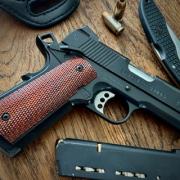I have seen many places refer to a "6 o'clock hold", but have never really understood what the specifics are. It is typically described at putting the top of front sight on the bottom of the bullseye. This is usually accompanied by a picture, like the one below. "Sight Image 1", on the left, is what's described as "6 o'clock hold", where the top of the front sight is placed right at the bottom of the cross-haired circle:
I also see this used in firearm owner's manuals. For example, the below is taken out of my Ruger 22/45 manual. Here the bullseye is a filled-in circle, but the top of the front sight is still meant to be placed on the bottom:
But like I said, I've never seen a definition, so I am curious. Is there an industry standard bulls eye target that is meant to be used, with a specific radius for the center circle? Maybe an NRA target, perhaps a B-8?
Does it matter what distance this is shot at, or does range not matter? When did this targeting approach get started, originally?




 Reply With Quote
Reply With Quote




